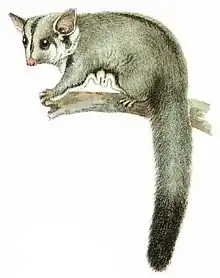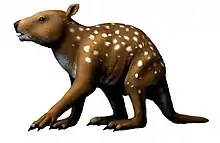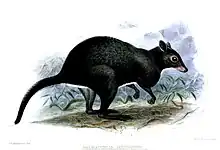| Pildra Temporal range: Late Oligocene - Early Miocene | |
|---|---|
| Scientific classification | |
| Domain: | Eukaryota |
| Kingdom: | Animalia |
| Phylum: | Chordata |
| Class: | Mammalia |
| Infraclass: | Marsupialia |
| Order: | Diprotodontia |
| Family: | Pseudocheiridae |
| Genus: | †Pildra Woodburne, Tedford & Archer 1987 |
| Species | |
|
Pildra antiquus | |
Pildra is an extinct genus of Pseudocheiridae from the Oligocene–Miocene of Australia.[1][2] Specimens have been collected from the Tirari Desert and Frome Basin in northern South Australia and the Oligo-Miocene freshwater limestone deposits of the Riversleigh World Heritage Area in northwestern Queensland.[3]
It is estimated to have weighed between 100 and 300 g (3.5 and 10.6 oz).[4]
References
- ↑ Megirian, D; Murray, P; Schwartz, L; von der Borch, C (8 September 2004). "Late Oligocene Kangaroo Well Local Fauna from the Ulta Limestone (new name), and climate of the Miocene oscillation across central Australia" (PDF). Australian Journal of Earth Sciences. 51: 701–741. Retrieved 6 November 2023.
- ↑ Megirian, Dirk; Prideaux, Gavin J; Murray, Peter F; Smit, Neil (2010). "An Australian land mammal age biochronological scheme" (PDF). Paleobiology. 36 (4): 658–671. Retrieved 6 November 2023.
- ↑ Roberts, Karen K; Archer, Michael; Hand, Suzanne J; Godthelp, Henk (8 March 2007). "New genus and species of extinct Miocene ringtail possums (Marsupialia: Pseudocheiridae)" (PDF). American Museum Novitates. 3560: 1–15. Retrieved 6 November 2023.
- ↑ Roberts, Karen K; Archer, Michael; Hand, Suzanne J; Godthelp, Henk (2009). "New Australian Oligocene to Miocene ringtail possums (Pseudocheiridae) and revision of the genus Marlu". Palaeontology. 52 (2): 441–456. doi:10.1111/j.1475-4983.2009.00852.x.
This article is issued from Wikipedia. The text is licensed under Creative Commons - Attribution - Sharealike. Additional terms may apply for the media files.



